Java后端开发三年多线程你都懂,问你异步编程你说你没听过???
2021-01-17 15:25
260 查看
前言
以前需要异步执行一个任务时,一般是用Thread或者线程池Executor去创建。如果需要返回值,则是调用Executor.submit获取Future。但是多个线程存在依赖组合,我们又能怎么办?可使用同步组件CountDownLatch、CyclicBarrier等;其实有简单的方法,就是用CompletableFuture
- 线程任务的创建
- 线程任务的串行执行
- 线程任务的并行执行
- 处理任务结果和异常
- 多任务的简单组合
- 取消执行线程任务
- 任务结果的获取和完成与否判断
1、创建异步线程任务
根据supplier创建CompletableFuture任务
//使用内置线程ForkJoinPool.commonPool(),根据supplier构建执行任务 public static <U> CompletableFuture<U> supplyAsync(Supplier<U> supplier) //指定自定义线程,根据supplier构建执行任务 public static <U> CompletableFuture<U> supplyAsync(Supplier<U> supplier, Executor executor)
根据runnable创建CompletableFuture任务
//使用内置线程ForkJoinPool.commonPool(),根据runnable构建执行任务 public static CompletableFuture<Void> runAsync(Runnable runnable) //指定自定义线程,根据runnable构建执行任务 public static CompletableFuture<Void> runAsync(Runnable runnable, Executor executor)
- 使用示例
ExecutorService executor = Executors.newSingleThreadExecutor();
CompletableFuture<Void> rFuture = CompletableFuture
.runAsync(() -> System.out.println("hello siting"), executor);
//supplyAsync的使用
CompletableFuture<String> future = CompletableFuture
.supplyAsync(() -> {
System.out.print("hello ");
return "siting";
}, executor);
//阻塞等待,runAsync 的future 无返回值,输出null
System.out.println(rFuture.join());
//阻塞等待
String name = future.join();
System.out.println(name);
executor.shutdown(); // 线程池需要关闭
--------输出结果--------
hello siting
null
hello siting
常量值作为CompletableFuture返回
//有时候是需要构建一个常量的CompletableFuture public static <U> CompletableFuture<U> completedFuture(U value)
2 、线程串行执行

任务完成则运行action,不关心上一个任务的结果,无返回值
public CompletableFuture<Void> thenRun(Runnable action) public CompletableFuture<Void> thenRunAsync(Runnable action) public CompletableFuture<Void> thenRunAsync(Runnable action, Executor executor)
- 使用示例
CompletableFuture<Void> future = CompletableFuture
.supplyAsync(() -> "hello siting", executor)
.thenRunAsync(() -> System.out.println("OK"), executor);
executor.shutdown();
--------输出结果--------
OK
任务完成则运行action,依赖上一个任务的结果,无返回值
public CompletableFuture<Void> thenAccept(Consumer<? super T> action) public CompletableFuture<Void> thenAcceptAsync(Consumer<? super T> action) public CompletableFuture<Void> thenAcceptAsync(Consumer<? super T> action, Executor executor)
- 使用示例
ExecutorService executor = Executors.newSingleThreadExecutor(); CompletableFuture<Void> future = CompletableFuture .supplyAsync(() -> "hello siting", executor) .thenAcceptAsync(System.out::println, executor); executor.shutdown(); --------输出结果-------- hello siting
任务完成则运行fn,依赖上一个任务的结果,有返回值
public <U> CompletableFuture<U> thenApply(Function<? super T,? extends U> fn) public <U> CompletableFuture<U> thenApplyAsync(Function<? super T,? extends U> fn) public <U> CompletableFuture<U> thenApplyAsync(Function<? super T,? extends U> fn, Executor executor)
- 使用示例
ExecutorService executor = Executors.newSingleThreadExecutor();
CompletableFuture<String> future = CompletableFuture
.supplyAsync(() -> "hello world", executor)
.thenApplyAsync(data -> {
System.out.println(data); return "OK";
}, executor);
System.out.println(future.join());
executor.shutdown();
--------输出结果--------
hello world
OK
thenCompose - 任务完成则运行fn,依赖上一个任务的结果,有返回值
- 类似thenApply(区别是thenCompose的返回值是CompletionStage,thenApply则是返回 U),提供该方法为了和其他CompletableFuture任务更好地配套组合使用
public <U> CompletableFuture<U> thenCompose(Function<? super T, ? extends CompletionStage<U>> fn) public <U> CompletableFuture<U> thenComposeAsync(Function<? super T, ? extends CompletionStage<U>> fn) public <U> CompletableFuture<U> thenComposeAsync(Function<? super T, ? extends CompletionStage<U>> fn, Executor executor)
- 使用示例
//第一个异步任务,常量任务
CompletableFuture<String> f = CompletableFuture.completedFuture("OK");
//第二个异步任务
ExecutorService executor = Executors.newSingleThreadExecutor();
CompletableFuture<String> future = CompletableFuture
.supplyAsync(() -> "hello world", executor)
.thenComposeAsync(data -> {
System.out.println(data); return f; //使用第一个任务作为返回
}, executor);
System.out.println(future.join());
executor.shutdown();
--------输出结果--------
hello world
OK
3 、线程并行执行
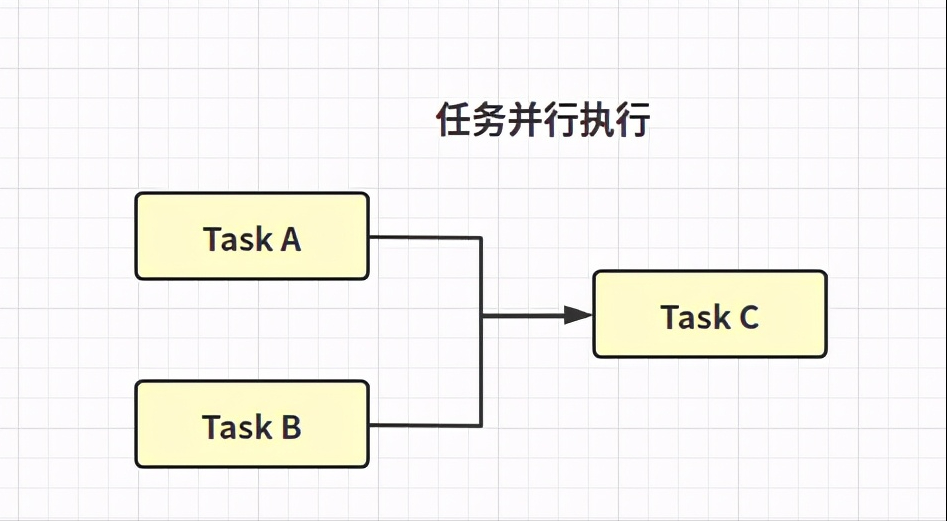
两个CompletableFuture[并行]执行完,然后执行action,不依赖上两个任务的结果,无返回值
public CompletableFuture<Void> runAfterBoth(CompletionStage<?> other, Runnable action) public CompletableFuture<Void> runAfterBothAsync(CompletionStage<?> other, Runnable action) public CompletableFuture<Void> runAfterBothAsync(CompletionStage<?> other, Runnable action, Executor executor)
- 使用示例
//第一个异步任务,常量任务
CompletableFuture<String> first = CompletableFuture.completedFuture("hello world");
ExecutorService executor = Executors.newSingleThreadExecutor();
CompletableFuture<Void> future = CompletableFuture
//第二个异步任务
.supplyAsync(() -> "hello siting", executor)
// () -> System.out.println("OK") 是第三个任务
.runAfterBothAsync(first, () -> System.out.println("OK"), executor);
executor.shutdown();
--------输出结果--------
OK
两个CompletableFuture[并行]执行完,然后执行action,依赖上两个任务的结果,无返回值
//第一个任务完成再运行other,fn再依赖消费两个任务的结果,无返回值 public <U> CompletableFuture<Void> thenAcceptBoth(CompletionStage<? extends U> other, BiConsumer<? super T, ? super U> action) //两个任务异步完成,fn再依赖消费两个任务的结果,无返回值 public <U> CompletableFuture<Void> thenAcceptBothAsync(CompletionStage<? extends U> other, BiConsumer<? super T, ? super U> action) //两个任务异步完成(第二个任务用指定线程池执行),fn再依赖消费两个任务的结果,无返回值 public <U> CompletableFuture<Void> thenAcceptBothAsync(CompletionStage<? extends U> other, BiConsumer<? super T, ? super U> action, Executor executor)
- 使用示例
//第一个异步任务,常量任务
CompletableFuture<String> first = CompletableFuture.completedFuture("hello world");
ExecutorService executor = Executors.newSingleThreadExecutor();
CompletableFuture<Void> future = CompletableFuture
//第二个异步任务
.supplyAsync(() -> "hello siting", executor)
// (w, s) -> System.out.println(s) 是第三个任务
.thenAcceptBothAsync(first, (s, w) -> System.out.println(s), executor);
executor.shutdown();
--------输出结果--------
hello siting
两个CompletableFuture[并行]执行完,然后执行action,依赖上两个任务的结果,有返回值
//第一个任务完成再运行other,fn再依赖消费两个任务的结果,有返回值 public <U,V> CompletableFuture<V> thenCombine(CompletionStage<? extends U> other, BiFunction<? super T,? super U,? extends V> fn) //两个任务异步完成,fn再依赖消费两个任务的结果,有返回值 public <U,V> CompletableFuture<V> thenCombineAsync(CompletionStage<? extends U> other, BiFunction<? super T,? super U,? extends V> fn) //两个任务异步完成(第二个任务用指定线程池执行),fn再依赖消费两个任务的结果,有返回值 public <U,V> CompletableFuture<V> thenCombineAsync(CompletionStage<? extends U> other, BiFunction<? super T,? super U,? extends V> fn, Executor executor)
- 使用示例
//第一个异步任务,常量任务
CompletableFuture<String> first = CompletableFuture.completedFuture("hello world");
ExecutorService executor = Executors.newSingleThreadExecutor();
CompletableFuture<String> future = CompletableFuture
//第二个异步任务
.supplyAsync(() -> "hello siting", executor)
// (w, s) -> System.out.println(s) 是第三个任务
.thenCombineAsync(first, (s, w) -> {
System.out.println(s);
return "OK";
}, executor);
System.out.println(future.join());
executor.shutdown();
--------输出结果--------
hello siting
OK
4 、线程并行执行,谁先执行完则谁触发下一任务(二者选其最快)
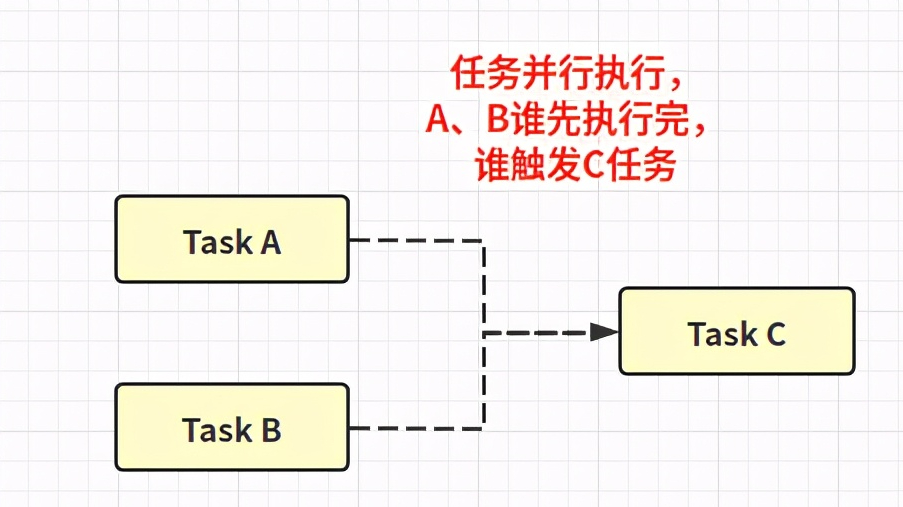
上一个任务或者other任务完成, 运行action,不依赖前一任务的结果,无返回值
public CompletableFuture<Void> runAfterEither(CompletionStage<?> other, Runnable action) public CompletableFuture<Void> runAfterEitherAsync(CompletionStage<?> other, Runnable action) public CompletableFuture<Void> runAfterEitherAsync(CompletionStage<?> other, Runnable action, Executor executor)
- 使用示例
//第一个异步任务,休眠1秒,保证最晚执行晚
CompletableFuture<String> first = CompletableFuture.supplyAsync(()->{
try{ Thread.sleep(1000); }catch (Exception e){}
System.out.println("hello world");
return "hello world";
});
ExecutorService executor = Executors.newSingleThreadExecutor();
CompletableFuture<Void> future = CompletableFuture
//第二个异步任务
.supplyAsync(() ->{
System.out.println("hello siting");
return "hello siting";
} , executor)
//() -> System.out.println("OK") 是第三个任务
.runAfterEitherAsync(first, () -> System.out.println("OK") , executor);
executor.shutdown();
--------输出结果--------
hello siting
OK
上一个任务或者other任务完成, 运行action,依赖最先完成任务的结果,无返回值
public CompletableFuture<Void> acceptEither(CompletionStage<? extends T> other, Consumer<? super T> action) public CompletableFuture<Void> acceptEitherAsync(CompletionStage<? extends T> other, Consumer<? super T> action, Executor executor) public CompletableFuture<Void> acceptEitherAsync(CompletionStage<? extends T> other, Consumer<? super T> action, Executor executor)
- 使用示例
//第一个异步任务,休眠1秒,保证最晚执行晚
CompletableFuture<String> first = CompletableFuture.supplyAsync(()->{
try{ Thread.sleep(1000); }catch (Exception e){}
return "hello world";
});
ExecutorService executor = Executors.newSingleThreadExecutor();
CompletableFuture<Void> future = CompletableFuture
//第二个异步任务
.supplyAsync(() -> "hello siting", executor)
// data -> System.out.println(data) 是第三个任务
.acceptEitherAsync(first, data -> System.out.println(data) , executor);
executor.shutdown();
--------输出结果--------
hello siting
上一个任务或者other任务完成, 运行fn,依赖最先完成任务的结果,有返回值
public <U> CompletableFuture<U> applyToEither(CompletionStage<? extends T> other, Function<? super T, U> fn) public <U> CompletableFuture<U> applyToEitherAsync(CompletionStage<? extends T> other, Function<? super T, U> fn) public <U> CompletableFuture<U> applyToEitherAsync(CompletionStage<? extends T> other, Function<? super T, U> fn, Executor executor)
- 使用示例
//第一个异步任务,休眠1秒,保证最晚执行晚
CompletableFuture<String> first = CompletableFuture.supplyAsync(()->{
try{ Thread.sleep(1000); }catch (Exception e){}
return "hello world";
});
ExecutorService executor = Executors.newSingleThreadExecutor();
CompletableFuture<String> future = CompletableFuture
//第二个异步任务
.supplyAsync(() -> "hello siting", executor)
// data -> System.out.println(data) 是第三个任务
.applyToEitherAsync(first, data -> {
System.out.println(data);
return "OK";
} , executor);
System.out.println(future);
executor.shutdown();
--------输出结果--------
hello siting
OK
5 、处理任务结果或者异常
exceptionally-处理异常
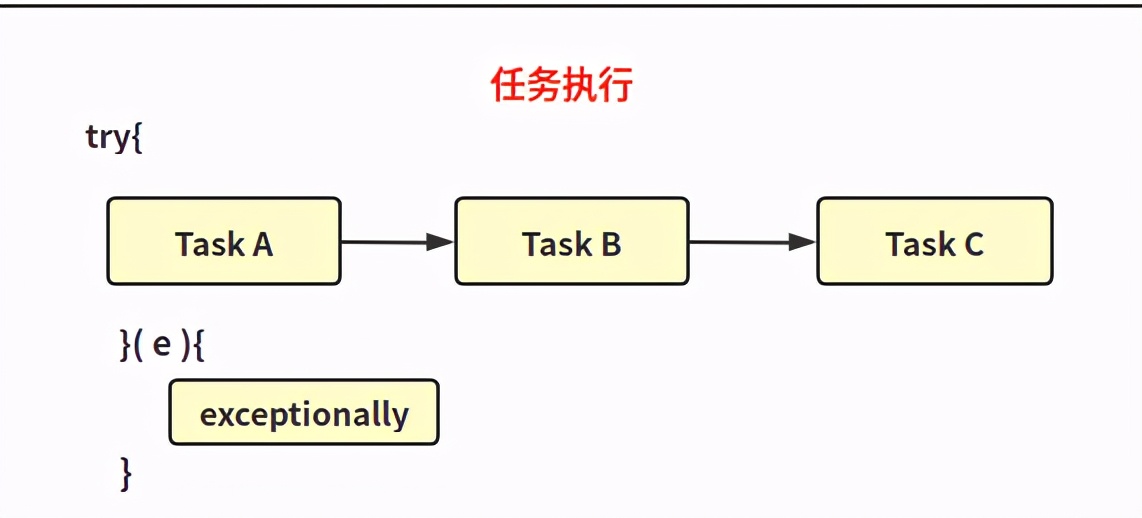
public CompletableFuture<T> exceptionally(Function<Throwable, ? extends T> fn)
- 如果之前的处理环节有异常问题,则会触发exceptionally的调用相当于 try...catch
- 使用示例
CompletableFuture<Integer> first = CompletableFuture
.supplyAsync(() -> {
if (true) {
throw new RuntimeException("main error!");
}
return "hello world";
})
.thenApply(data -> 1)
.exceptionally(e -> {
e.printStackTrace(); // 异常捕捉处理,前面两个处理环节的日常都能捕获
return 0;
});
handle-任务完成或者异常时运行fn,返回值为fn的返回
- 相比exceptionally而言,即可处理上一环节的异常也可以处理其正常返回值
public <U> CompletableFuture<U> handle(BiFunction<? super T, Throwable, ? extends U> fn) public <U> CompletableFuture<U> handleAsync(BiFunction<? super T, Throwable, ? extends U> fn) public <U> CompletableFuture<U> handleAsync(BiFunction<? super T, Throwable, ? extends U> fn, Executor executor)
- 使用示例
CompletableFuture<Integer> first = CompletableFuture
.supplyAsync(() -> {
if (true) { throw new RuntimeException("main error!"); }
return "hello world";
})
.thenApply(data -> 1)
.handleAsync((data,e) -> {
e.printStackTrace(); // 异常捕捉处理
return data;
});
System.out.println(first.join());
--------输出结果--------
java.util.concurrent.CompletionException: java.lang.RuntimeException: main error!
... 5 more
null
whenComplete-任务完成或者异常时运行action,有返回值
- whenComplete与handle的区别在于,它不参与返回结果的处理,把它当成监听器即可
- 即使异常被处理,在CompletableFuture外层,异常也会再次复现
- 使用whenCompleteAsync时,返回结果则需要考虑多线程操作问题,毕竟会出现两个线程同时操作一个结果
public CompletableFuture<T> whenComplete(BiConsumer<? super T, ? super Throwable> action) public CompletableFuture<T> whenCompleteAsync(BiConsumer<? super T, ? super Throwable> action) public CompletableFuture<T> whenCompleteAsync(BiConsumer<? super T, ? super Throwable> action, Executor executor)
- 使用示例
CompletableFuture<AtomicBoolean> first = CompletableFuture
.supplyAsync(() -> {
if (true) { throw new RuntimeException("main error!"); }
return "hello world";
})
.thenApply(data -> new AtomicBoolean(false))
.whenCompleteAsync((data,e) -> {
//异常捕捉处理, 但是异常还是会在外层复现
System.out.println(e.getMessage());
});
first.join();
--------输出结果--------
java.lang.RuntimeException: main error!
Exception in thread "main" java.util.concurrent.CompletionException: java.lang.RuntimeException: main error!
... 5 more
6 、多个任务的简单组合
public static CompletableFuture<Void> allOf(CompletableFuture<?>... cfs) public static CompletableFuture<Object> anyOf(CompletableFuture<?>... cfs)
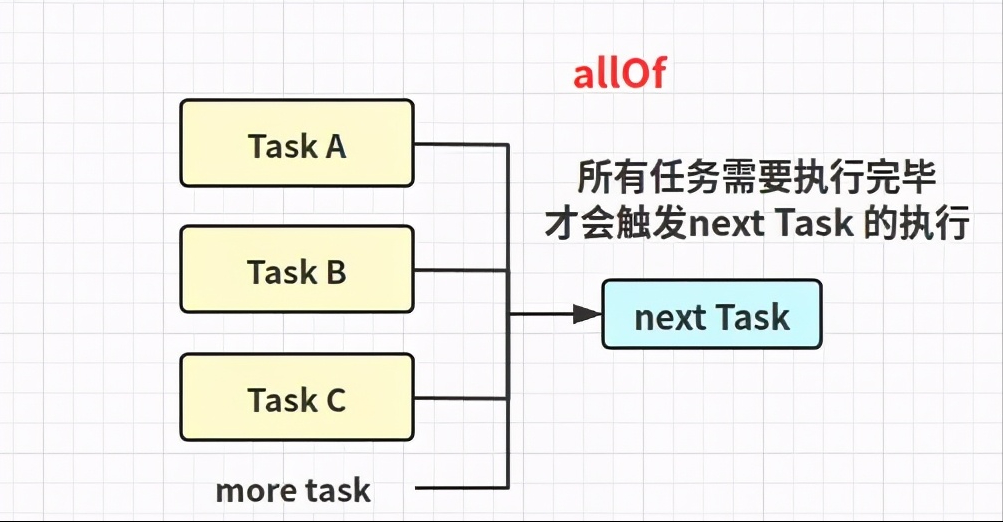
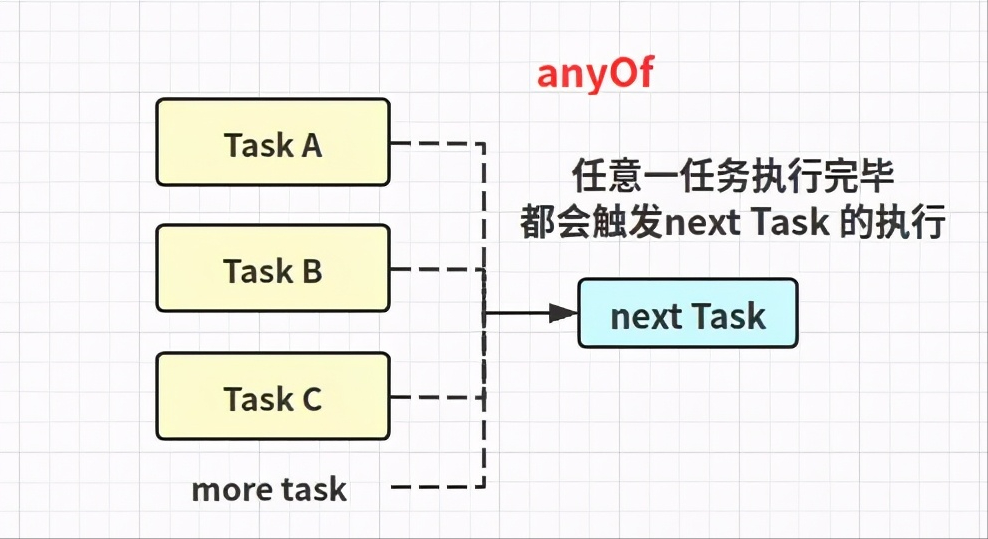
- 使用示例
CompletableFuture<Void> future = CompletableFuture
.allOf(CompletableFuture.completedFuture("A"),
CompletableFuture.completedFuture("B"));
//全部任务都需要执行完
future.join();
CompletableFuture<Object> future2 = CompletableFuture
.anyOf(CompletableFuture.completedFuture("C"),
CompletableFuture.completedFuture("D"));
//其中一个任务行完即可
future2.join();
7、取消执行线程任务
// mayInterruptIfRunning 无影响;如果任务未完成,则返回异常 public boolean cancel(boolean mayInterruptIfRunning) //任务是否取消 public boolean isCancelled()
- 使用示例
CompletableFuture<Integer> future = CompletableFuture
.supplyAsync(() -> {
try { Thread.sleep(1000); } catch (Exception e) { }
return "hello world";
})
.thenApply(data -> 1);
System.out.println("任务取消前:" + future.isCancelled());
// 如果任务未完成,则返回异常,需要对使用exceptionally,handle 对结果处理
future.cancel(true);
System.out.println("任务取消后:" + future.isCancelled());
future = future.exceptionally(e -> {
e.printStackTrace();
return 0;
});
System.out.println(future.join());
--------输出结果--------
任务取消前:false
任务取消后:true
java.util.concurrent.CancellationException
at java.util.concurrent.CompletableFuture.cancel(CompletableFuture.java:2276)
at Test.main(Test.java:25)
0
8、任务的获取和完成与否判断
// 任务是否执行完成 public boolean isDone() //阻塞等待 获取返回值 public T join() // 阻塞等待 获取返回值,区别是get需要返回受检异常 public T get() //等待阻塞一段时间,并获取返回值 public T get(long timeout, TimeUnit unit) //未完成则返回指定value public T getNow(T valueIfAbsent) //未完成,使用value作为任务执行的结果,任务结束。需要future.get获取 public boolean complete(T value) //未完成,则是异常调用,返回异常结果,任务结束 public boolean completeExceptionally(Throwable ex) //判断任务是否因发生异常结束的 public boolean isCompletedExceptionally() //强制地将返回值设置为value,无论该之前任务是否完成;类似complete public void obtrudeValue(T value) //强制地让异常抛出,异常返回,无论该之前任务是否完成;类似completeExceptionally public void obtrudeException(Throwable ex)
- 使用示例
CompletableFuture<Integer> future = CompletableFuture
.supplyAsync(() -> {
try { Thread.sleep(1000); } catch (Exception e) { }
return "hello world";
})
.thenApply(data -> 1);
System.out.println("任务完成前:" + future.isDone());
future.complete(10);
System.out.println("任务完成后:" + future.join());
--------输出结果--------
任务完成前:false
任务完成后:10
总结
Java 多线程一直是面试时候的重点,也是能力提升的重要体现,如何做到波澜不惊,从容面对,需要我们对其中的内容融汇贯通,小编这里也对应总结了一份多线程-并发编程的思维导图,需要的朋友可以看看,关注公众号:麒麟改bug,还可以领取一份包含了Java基础、Java集合容器、Java异常、并发编程、JVM、Spring、Spring MVC、Spring Boot、Spring Cloud、MyBatis、Redis、MySQL数据库、消息中间件MQ与RabbitMQ、Dubbo、Linux、Tomcat、ZooKeeper、Netty、 架构设计&分布式&数据结构与算法等等,都是互联网大厂的面试真题,已经有粉丝靠这份PDF拿下众多大厂的offer。
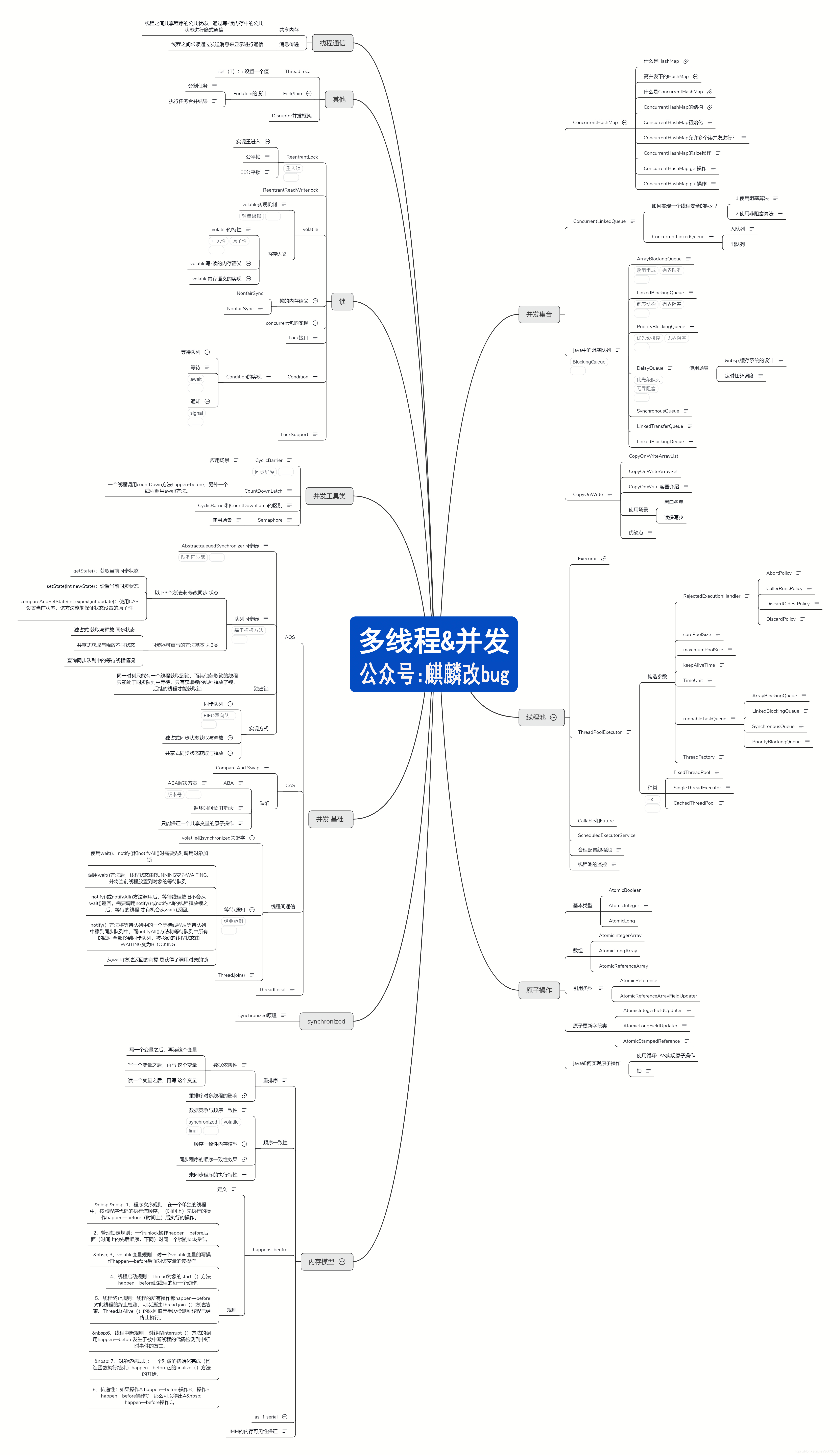
欢迎大家一起交流,喜欢文章记得关注我点赞哟,感谢支持!
相关文章推荐
- Java知识点整理:第十四章:java多线程编程、创建一个线程、异步与同步、java反射、类加载
- Java 线程/内存模型的缺陷和增强-Java基础-Java-编程开发
- 【java编程开发】线程详解及源码(史上最经典的线程详解)
- JAVA游戏编程之二----j2me MIDlet 手机游戏入门开发--扫雷(3)-带线程--仿windows扫雷
- 编程技巧:在Java应用开发中如何使用线程
- JAVA游戏编程之二----j2me MIDlet 手机游戏入门开发--扫雷(2)-不含线程
- JAVA专题技术综述之线程篇-Java基础-Java-编程开发
- Java十年,编程高手盘点开发经验(转贴)
- 编写一个JAVA的队列类-Java基础-Java-编程开发
- Java游戏编程---Java 线程
- Java传说之风云再起-Java基础-Java-编程开发
- Java中对HashMap的深度分析与比较-Java基础-Java-编程开发
- 深入探索CORBA对象生命周期之慨述-Java基础-Java-编程开发
- Java开发中的线程安全选择与Swing
- 编写高效的JAVA程序-编程规范 (开发篇 )
- Java编程规则-Java基础-Java-编程开发
- java 经验大放送 1-Java基础-Java-编程开发
- Java学习从入门到精通 1工具篇-Java基础-Java-编程开发
- 谈谈JAVA程序的反编译-Java基础-Java-编程开发
- Java咖啡馆(5)——Java语言基础-Java基础-Java-编程开发
